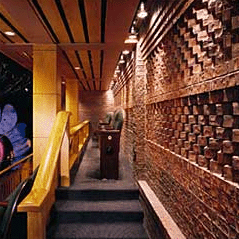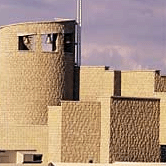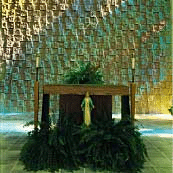Colored Mortars
By Jamie Farny
 Masonry, in all its varieties, allows for unlimited architectural expressions. The shapes, sizes, colors, textures and finishes of the units and joints can be combined in endless variations. Complementary or contrasting, colors of units and joints create the wall's overall perceived color. The minor fluctuations in shade and texture impart depth and character to masonry structures. Masonry, with its hand-assembled heritage, is in part appealing because each wall is unique.
Masonry, in all its varieties, allows for unlimited architectural expressions. The shapes, sizes, colors, textures and finishes of the units and joints can be combined in endless variations. Complementary or contrasting, colors of units and joints create the wall's overall perceived color. The minor fluctuations in shade and texture impart depth and character to masonry structures. Masonry, with its hand-assembled heritage, is in part appealing because each wall is unique.
Mortar should always be considered in designing a wall for maximum architectural impact. It is a cost-effective means of upgrading the wall's aesthetics. Beyond color, a wide variety of joint treatments, even the size of the joint, play a prominent role in the resulting look. Along with design, construction practices and techniques contribute to the final appearance of each joint.
Because colored mortars are chosen for their appearance, they may be noticed more than gray mortars. The key to consistent colors is keeping everything the same from one batch to the next ? the same materials, the same proportions, the same mixing, handling, placing and tooling techniques.
Tinting a Mortar
 Very fine particles, like cements and pigments, have the greatest effect on mortar color. Not all cements have the same color; there will be variations in shade depending on raw materials and manufacturing processes. White cements ? Portland or masonry ? lead to the truest mortar colors, especially for lighter shades or pastels.
Very fine particles, like cements and pigments, have the greatest effect on mortar color. Not all cements have the same color; there will be variations in shade depending on raw materials and manufacturing processes. White cements ? Portland or masonry ? lead to the truest mortar colors, especially for lighter shades or pastels.
Pigments for mortars need to be compatible with cement and lime and be colorfast and stable. Natural or synthetic mineral oxides generally meet these criteria. Pre-mixed colored cement products are preferable, but if blending cements and pigments on-site is necessary, pre-weighed pigment packages are available. Job site blending is not as easy as using premixed materials, but yields excellent results as long as strict attention is paid to consistent proportioning.
Sand, too, has the ability to lend color to a mortar, especially as the cement paste wears away and exposes the sand aggregates. When color is important, you can use the various available cements and sands in your area to make comparative mortar samples.
Getting the Best Color
 There are several practices that improve color uniformity. Using the same materials throughout a project is ideal. If there is adequate storage on site, all of the sand can be delivered ahead of time. Cement should be from one source, too, and if bags are used, they have to be protected from moisture: Store them on top of pallets and cover them with tarps.
There are several practices that improve color uniformity. Using the same materials throughout a project is ideal. If there is adequate storage on site, all of the sand can be delivered ahead of time. Cement should be from one source, too, and if bags are used, they have to be protected from moisture: Store them on top of pallets and cover them with tarps.
Field procedures affect mortar color. Accurate batching and thorough mixing lead to consistent color. A box of known unit volume can be used to calibrate sand additions to the mixer (such as shovel counts) and as a periodic check for workers to be sure they are adding the right amount of sand. Controlling the sand addition is a simple check on proportions.
Ambient temperature and humidity conditions affect mortar workability. Add enough water to get constant consistency from batch to batch. Small water adjustments should have negligible effect on mortar color. Mix only as much mortar as can be used in a reasonable period of time. Cover the mortar to minimize evaporation and retain workability. Re-tempering colored mortars should be avoided.
Normally, mixing times from three to five minutes are adequate ? once all ingredients are in the mixer. With colored mortars, the longer mixing times assure thorough blending and give better results.
Tooling and Curing
Like other aspects of colored mortars, timing the tooling of joints should be consistent over the entire wall surface. Early joint finishing generally leads to a lighter joint color, and later finishing to a darker color. If the mortar is stiff, then dark, streaked surfaces can result. The appropriate time to tool the joint is at "thumbprint" hardness, when a thumb can barely make an impression in the joint.
Durable mortar that withstands weather and tight joints that keep out water are more likely when curing is accomplished. Mortar usually contains enough moisture to provide adequate curing. Extra moisture or protection may be required when winds, sunlight or heat are excessive.
Reliable Performance with Enduring Beauty
Bringing color and texture to masonry walls is possible with both the units and the joints, so it's easy to add eye-catching appeal. In addition to its attractive appearance, masonry remains a popular architectural material because it is durable and low maintenance while keeping its occupants safe and comfortable.
About the Author
Jamie Farny is the Program Manager of Masonry and Special Products for the Portland Cement Association, coordinating research and promotion activities regarding cements for masonry and white cement. He participates on committees on concrete, plastering, mortars, and masonry units of the American Society for Testing and Materials and the American Concrete Institute. He holds a B.S. in Civil Engineering from the Illinois Institute of Technology.


















